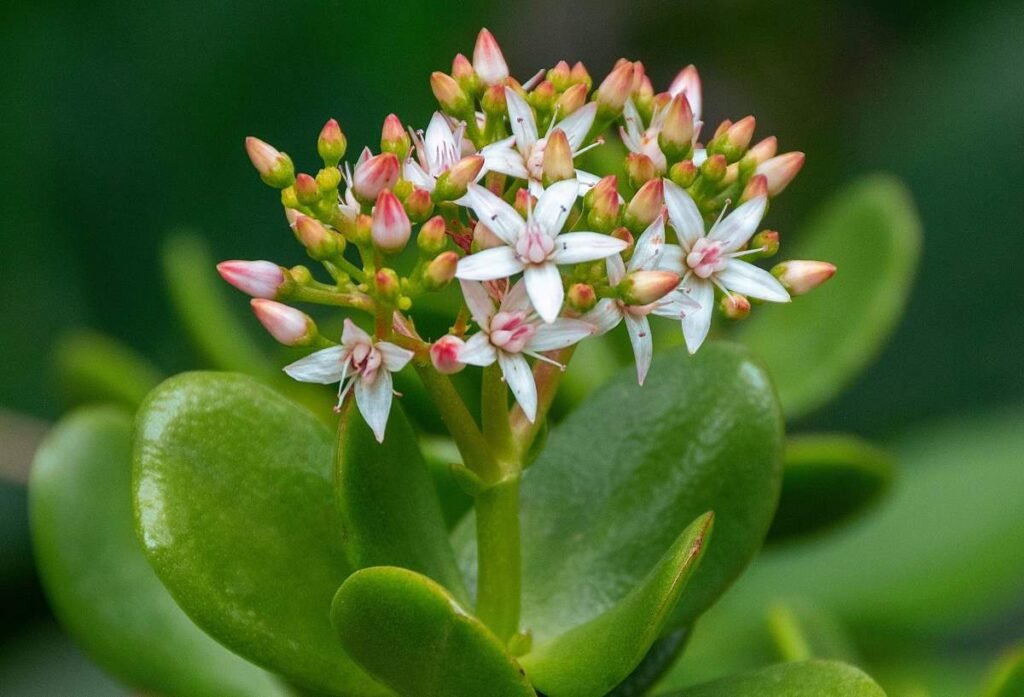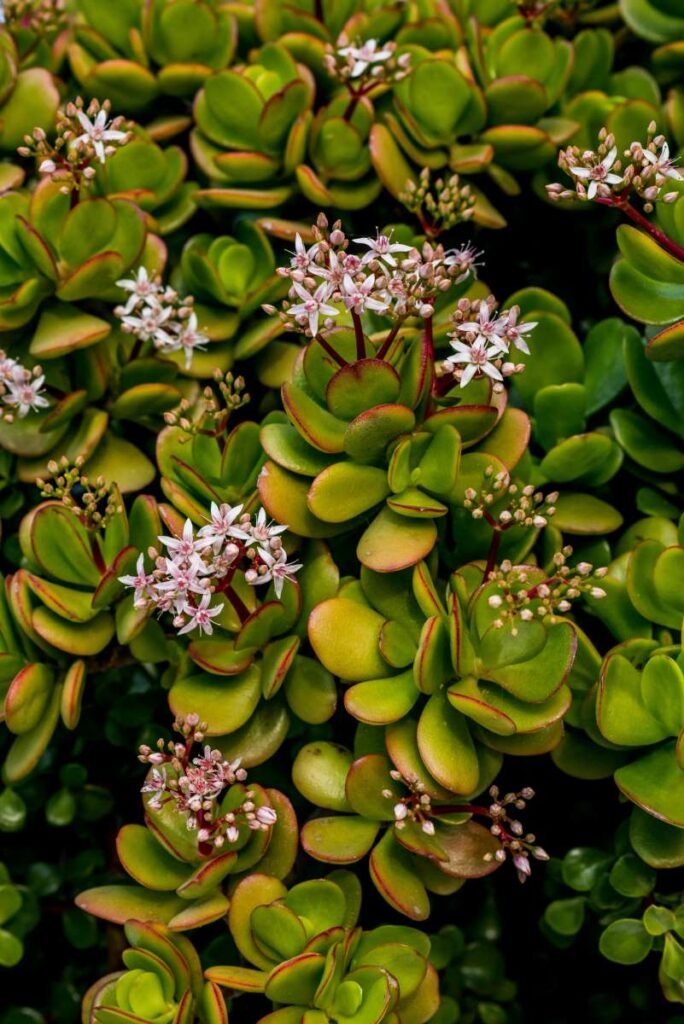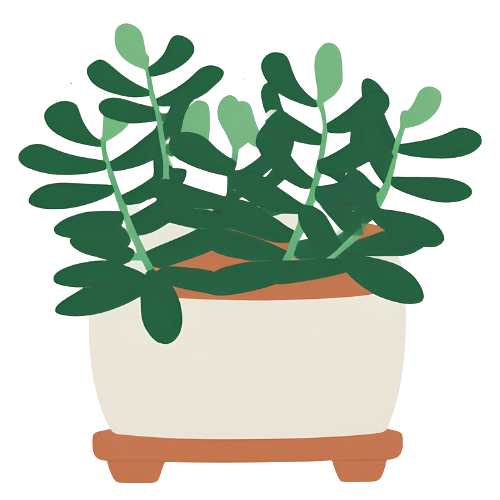I still remember the first time one of my jade plants bloomed. It was a cold January morning, and I noticed tiny star-shaped buds forming at the tips of the branches.
I had owned jade plants for years but had never seen flowers. What a gift! Those small white blooms with their sweet scent made me fall in love with my jade plant all over again.
Jade plants (Crassula ovata) are known for their thick, oval leaves and tree-like growth. Most people grow them for years without ever seeing them bloom. In fact, many jade plant owners don’t even know their plants can flower!
But under the right conditions, these hardy succulents will reward you with clusters of dainty, star-shaped blooms that look like a dusting of snow on the plant’s tips.
In this guide, I’ll share everything I’ve learned about jade plant flowers – from what triggers blooming to how you can increase your chances of seeing these special blossoms.
Whether you’re a new jade plant owner or have been growing them for years, this information will help you understand the magic of jade plant flowers.
Table of Contents
What Do Jade Plant Flowers Look Like?

Jade plant flowers are small but stunning. Here’s what you can expect when your plant decides to bloom:
- Size: Each flower is tiny – about ¼ to ½ inch across.
- Color: Most jade plants produce white or pale pink star-shaped flowers.
- Arrangement: The flowers grow in clusters at the tips of branches, forming rounded groups that can be 1-2 inches wide.
- Shape: Each flower has a star shape with five pointed petals.
- Scent: Many jade flowers have a sweet, honey-like fragrance that’s strongest in the morning.
The first time I saw jade flowers, I was struck by how they seemed to glow against the dark green leaves. The contrast is beautiful! The flowers look delicate compared to the thick, sturdy leaves of the plant.
Some jade plant varieties produce flowers in different colors. For example, ‘Pink Beauty’ has deeper pink blooms, while some rare varieties may have flowers with a slight yellow tint. But the classic white star-shaped blooms are the most common.
When Do Jade Plants Flower?

Jade plants have specific blooming seasons and conditions:
- Season: Most jade plants bloom in late winter to early spring (December to March in the Northern Hemisphere).
- Plant Age: Jade plants usually need to be mature – at least 5-6 years old – before they’ll bloom.
- Light Cycles: Short days and long nights trigger flowering, which is why winter is the typical blooming season.
I’ve noticed that the timing can vary based on your location. My jade plants in cooler rooms tend to bloom earlier than those in warmer spots. And some years, they bloom more heavily than others.
It’s important to note that jade plants grown indoors often don’t bloom at all. In fact, many jade plants live their whole lives without flowering. This doesn’t mean they’re unhealthy – it just means the conditions haven’t been right to trigger blooming.
Why Won’t My Jade Plant Flower?
If your jade plant hasn’t flowered yet, don’t worry! There are several reasons this might be happening:
- It’s too young: Plants younger than 5-6 years rarely bloom.
- Not enough light: Jade plants need bright light to store enough energy for flowering.
- Too much water: Overwatering, especially in winter, prevents blooming.
- Too warm in winter: Jade plants need cool winter temperatures (around 50-55°F at night) to trigger flowering.
- Not enough stress: Oddly enough, jade plants bloom best when slightly stressed.
- Year-round stable conditions: If your plant gets the same care all year, it may not get the seasonal cues it needs to bloom.
My oldest jade lived for 12 years without flowering. Then I moved it to a cooler room with a north-facing window and reduced winter watering. The very next winter, it burst into bloom! Sometimes small changes make all the difference.
How to Encourage Your Jade Plant to Flower
While there’s no guarantee your jade plant will bloom, you can create conditions that make flowering more likely:
1. Provide the Right Light
Jade plants need plenty of light to store energy for flowering:
- Place your plant in a south-facing window (northern hemisphere) for maximum light.
- During summer, jade plants can go outdoors in a spot with morning sun and afternoon shade.
- In winter, make sure they get as much natural light as possible.
- Consider using grow lights during dark winter months.
I’ve found that jade plants that spend summer outdoors are more likely to bloom the following winter. The extra light helps them store energy for flower production.
2. Create a Cool Winter Rest Period
This is perhaps the most important factor for blooming:
- In fall, gradually reduce watering.
- Keep winter temperatures cooler – ideally 50-55°F at night and 65-70°F during the day.
- Make sure the plant experiences natural winter light cycles with shorter days.
- Stop fertilizing completely in fall and winter.
My jade plants that bloom reliably all experience a temperature drop at night. If you keep your home warm all winter, try placing your jade in a cooler room or near a window where temperatures drop at night.
3. Practice Proper Watering
Proper watering creates just enough stress to encourage blooming:
- Let the soil dry completely between waterings.
- Water much less in winter – perhaps only once a month.
- Never let the plant sit in water.
- Use well-draining soil to prevent root rot.
I used to water my jade plants on a strict schedule. Now I check the soil and only water when it’s completely dry. This approach has led to much better flowering.
4. Use the Right Fertilizer
Feeding your jade plant properly can help with flower production:
- Use a low-nitrogen, high-phosphorus fertilizer (like one labeled for flowering plants or succulents).
- Fertilize only during the growing season (spring and summer).
- Dilute the fertilizer to half the recommended strength.
- Stop all fertilizer at least 2 months before the expected blooming season.
A bloom-boosting fertilizer with a higher middle number (the phosphorus content) can encourage flower development. But don’t overdo it – jade plants don’t need much fertilizer.
5. Allow for Root-Binding
Jade plants that are slightly root-bound often bloom better:
- Don’t rush to repot your jade plant.
- Use a pot that’s just big enough for the root system.
- Repot only when absolutely necessary, and use a pot just one size larger.
My most reliable bloomer is in a pot that looks too small for it. The tight quarters seem to create just the right amount of stress to trigger flowering.
6. Provide Good Air Circulation
Good air flow helps prevent pest problems and creates healthier plants that are more likely to bloom:
- Place jade plants where air can flow around them.
- Use a small fan if your plant is in a stuffy corner.
- If outdoors in summer, make sure the plant isn’t crowded by other plants.
I’ve noticed that jade plants that spend time outdoors with good air movement tend to be stronger and more likely to flower when brought back inside for winter.
What to Do When Your Jade Plant is Flowering

When those precious buds appear, you’ll want to give your plant special care:
- Don’t move the plant. Once buds form, keep your jade plant in the same spot. Moving it can cause buds to drop.
- Maintain consistent care. Continue the same watering and light routine that led to bud formation.
- Avoid touching the flowers. The oils from our skin can damage delicate blooms.
- Take photos! Jade flowers don’t last forever, so document this special event.
- Enjoy the fragrance. Smell the sweet scent in the morning when it’s strongest.
My first jade blooms lasted about three weeks. I took photos from the first tiny buds to the full bloom stage. Now I have a record of that special event to look back on.
After Flowering Care
Once the blooming period ends, your jade plant will need some recovery time:
- Deadhead spent flowers. When blooms fade, gently remove them to keep the plant looking tidy and prevent energy waste.
- Resume normal care. Gradually return to your regular watering schedule as spring approaches.
- Consider fertilizing. About a month after blooming ends, you can give your plant a light feeding to help it recover.
- Watch for new growth. Healthy plants often put out new leaves after flowering.
After my jade plants bloom, I give them a little extra attention. Flowering takes energy, so the plant may need time to rebuild its reserves.
Pollination and Seeds
If you’re curious about jade plant reproduction, here’s what happens after flowering:
- Pollination: In nature, insects pollinate jade flowers. Indoors, you can try hand-pollination with a small paintbrush moved from flower to flower.
- Seed formation: If pollination occurs, tiny green seed pods will form where the flowers were.
- Seed collection: When pods dry and turn brown, collect the tiny seeds inside.
- Germination: Jade seeds can be planted in well-draining soil and kept lightly moist until they sprout.
I’ve tried hand-pollinating my jade flowers with mixed results. It’s fun to try, but jade plants are much easier to propagate from stem or leaf cuttings than from seeds.
The Meaning of Jade Plant Flowers
In many cultures, jade plants have special meanings, and their flowers are even more significant:
- Good fortune: A flowering jade plant is said to bring financial luck and prosperity.
- Friendship: In some traditions, jade flowers represent the blossoming of friendship.
- Renewal: The winter blooms symbolize life continuing even in dormant seasons.
I like to think of jade flowers as a reward for patient care. When these plants bloom, it’s as if they’re saying “thank you” for creating the right conditions for them to thrive.
Different Jade Plant Varieties and Their Flowers
While the common jade plant (Crassula ovata) is the one most of us grow, there are other varieties with unique flowering characteristics:
Crassula ovata ‘Hummel’s Sunset’
- Golden-edged leaves that turn more orange-red in cool weather
- Traditional white to pale pink star-shaped flowers
- Often blooms more readily than standard jade plants
Crassula ovata ‘Pink Beauty’
- Leaf edges tinted with pink
- Darker pink flowers than the standard jade
- Needs very bright light to develop good color
Crassula arborescens (Silver Jade)
- Blue-gray leaves with red edges
- White to pale pink flowers similar to common jade
- May be more difficult to bring to bloom
My collection includes several jade varieties. The ‘Hummel’s Sunset’ is the most reliable bloomer, producing flowers almost every year. The standard green jade blooms less often but produces more flowers when it does.
Common Problems During the Flowering Period
Sometimes issues can arise when your jade plant is in bloom:
Bud Drop
If flower buds form but fall off before opening:
- The plant may have been moved or rotated
- There could be drafts or temperature fluctuations
- The air might be too dry
- Watering may be inconsistent
Short Blooming Period
If flowers don’t last long:
- Indoor air may be too warm
- Humidity might be too low
- The plant could be in a high-traffic area with too much disturbance
Weak or Small Flower Clusters
If flower clusters seem sparse or small:
- The plant may need more light
- It might need more nutrients during the growing season
- Age could be a factor (young plants produce fewer flowers)
Once, my jade plant dropped all its buds after I moved it to show a friend. I learned the hard way that once buds form, the plant should stay put until flowering is complete.
Myths About Jade Plant Flowers
There are several myths about jade plant flowers that need clearing up:
Myth 1: Jade plants will never bloom indoors
Truth: While it’s more challenging, indoor jade plants can definitely bloom with the right conditions.
Myth 2: You need to withhold water completely to force blooming
Truth: Reduced watering helps, but completely withholding water can harm the plant. The soil should dry out between waterings but not for extended periods.
Myth 3: Only very old plants will bloom
Truth: While maturity helps, even 4-5 year old plants can bloom if conditions are right.
Myth 4: Once a jade plant blooms, it will die
Truth: This is completely false. Jade plants can bloom year after year and live for decades.
I once believed I needed to starve my jade plants of water to make them bloom. This just led to shriveled leaves and stress. Proper dormancy with reduced (not eliminated) water works much better.
Documenting Your Jade Plant’s Flowering Journey
Keeping track of your jade plant’s growth and flowering can help you understand what conditions work best:
- Take photos of your plant throughout the year.
- Note the date when buds first appear.
- Track how long the flowering period lasts.
- Record care details like watering frequency, light exposure, and temperature.
- Compare year to year to see patterns.
I keep a small plant journal where I note when my jade plants bloom. Over time, I’ve seen that years with cooler fall temperatures tend to produce more flowers the following winter.
The Joy of Sharing Flowering Jade Plants
When your jade plant blooms, it’s a special event worth sharing:
- Take cuttings after flowering to share with friends.
- Share photos of the blooms on social media or gardening forums.
- Gift small jade plants with care instructions that encourage blooming.
- Host a “plant party” when your jade is in full bloom.
I’ve given dozens of jade plant cuttings to friends. I always include a photo of the parent plant in bloom so they know what’s possible with proper care.
Comparing Jade Flowers to Other Succulent Blooms
If you grow other succulents, you might wonder how jade flowers compare:
- Jade flowers are smaller than many other succulent blooms like those of Echeveria or Kalanchoe.
- Blooming frequency is lower in jade plants than in many other succulents.
- Flower shape (star-shaped with five petals) is distinctive to Crassula species.
- Seasonal timing (winter to early spring) differs from many summer-blooming succulents.
In my collection, my Echeverias bloom almost yearly with minimal effort, while my jades are more selective about when they’ll flower. But jade flowers have a delicacy and sweetness that makes the wait worthwhile.
My Personal Journey with Jade Plant Flowers
My first jade plant was a cutting from my grandmother’s massive plant. For years, I grew it without knowing it could bloom. Then one winter, after I’d moved to a house with cooler temperatures, I noticed tiny buds forming.
The anticipation as those buds slowly opened was magical. When the full clusters of white stars finally appeared, I called my grandmother to tell her. To my surprise, she said her plant had never bloomed in thirty years of growing it!
Since then, I’ve become somewhat obsessed with jade plant flowers. I’ve adjusted care for all my jade plants with blooming in mind. Some years are better than others, but the joy of seeing those star-shaped blooms never fades.
Final Thoughts on Jade Plant Flowers
Jade plant flowers remind us that patience in gardening often brings unexpected rewards. These plants don’t bloom easily or predictably, which makes their flowers all the more special when they appear.
If your jade plant hasn’t flowered yet, don’t give up hope. Keep providing good care, create those cool winter conditions, and one day you might be surprised by tiny star-shaped buds forming at the branch tips.
And if your jade never blooms? That’s okay too. These plants are beautiful, long-lived companions whether they flower or not. Their thick, glossy leaves and tree-like form have earned them a place in homes worldwide.
But if you do witness the magic of jade plant flowers, take a moment to appreciate this special gift. In a world where instant gratification is the norm, there’s something deeply satisfying about the patience and care rewarded by these delicate winter blooms.
Happy growing!

My name is Shahriar Robin, and I’m the creator of JadePlants.org. Growing up in a village, I developed a deep connection with nature from a young age. Plants and gardening have always been a part of my life, and jade plants, with their resilience and elegance, have held a special place in my heart. Over the years, I’ve learned so much about these fascinating plants, and I created this site to share that knowledge with you—completely free of charge.

